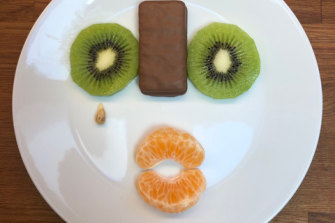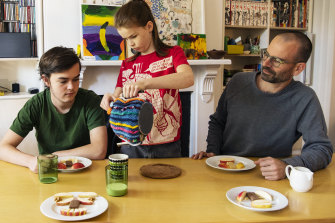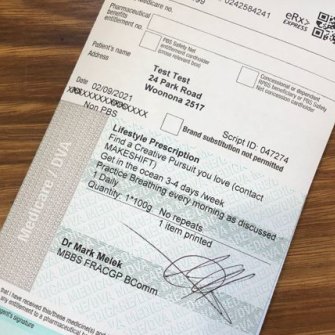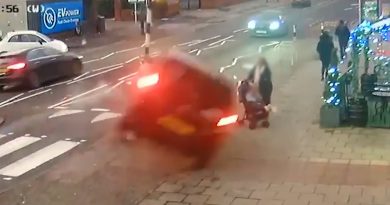Lockdown: Measuring your life in morning teas, photos, and a stitch in time
By Julie Power
Stefan Lie of Bondi Junction has been capturing the mood of his family lockdown when he prepares morning and afternoon tea for his two school-age children. The theme of this snack was: “Tears – Of frustration, sadness and joy we shed them all.”Credit:Stefan Lie
For our free coronavirus pandemic coverage, learn more here.
Stefan Lie understands how an orange pip can resemble a tear when arranged creatively on a plate of snacks for afternoon or morning tea. Cashews make funny eyes.
A strawberry cut in half to look like “red lips” elicited laughs from his children on one of the “darkest days of lockdown” when the Bondi Junction family heard homeschooling would continue for months.
Dr Lie went bananas when a resident from Sydney’s eastern suburbs who had tested positive for COVID-19 went property shopping up north in Byron Bay.
A product designer and academic at the University of Technology (Sydney), he channelled his creativity into representing the family’s anger with a menacing banana that seems to bare its teeth.
Artist and academic Stefan Lie having afternoon tea, during lockdown with children Rolf and Tino at their Bondi Junction home. Credit:Louise Kennerley
As he has done every day of lockdown, Dr Lie photographed the plate of biscuits and fruit (often rushing before the kids hoe in) as a record of that day’s mood at home.
The image was called, “Angry: He really went to Byron to look at real estate.”
“I was so mad,” Dr Lie says. His photos last year of morning and afternoon teas were featured with another 59 artists in the Australian Design Centre’s project Design/Isolate.
In the pandemic, many people like Dr Lie have found solace and joy from daily habits and creative practices that mark the day and distract them from doomscrolling the latest COVID-19 case numbers.
Now in what she calls “lockdown 6.5”, Melbourne photographer Alana Holmberg decided to photograph people every day from her front porch in Brunswick. It was a visual diary that started as “a reflection on the role of community as a remedy for isolation” that she has continued.
She became so embedded in her community that it gave her a sense of belonging and place: “Because I was getting my social hit, sitting on the porch for hours on end, it taught me the possibility for belonging, friendship and care with people who aren’t in your immediate circles or family.”
The project grew to include photos of 244 individuals. Her book, Porch Diaries, will be released this weekend.
In NSW’s Blackheath, textile designer Julie Paterson started a community art project on Instagram to create a sense of community in lockdown by participating in an “impermanent art practice”.
She encourages people to create ephemeral artworks out of what they find on daily walks: sticks, flowers, stones, rubbish, etc. And she encourages non-creative types of people to enjoy doing it badly.
“Creating an ephemeral artwork is like a conscious form of doodling,” she says. “It gives me joy.”
Designed to get people outdoors, boost creativity, improve mental health, and strengthen the sense of connection with nature and community, it is continuing now as #everysevendays2021.
Routine and daily activities “anchor our day, and help us feel connected and stable in times of crisis”, says associate professor Elizabeth Scott from the University of Sydney.
A specialist in circadian dysfunction, mood disorders and mental health, Professor Scott says COVID-19 had been bad for mental health. It has resulted in a 45 per cent increase in presentations to emergency departments and increasing rates of depression and anxiety.
Yet at the same time, there had been an incredible growth in ideas and solutions by the creative sector to help manage this crisis, says Professor Scott, a principal research fellow at the University’s Brain and Mind Centre.
Lisa Cahill, the chief executive of the Australian Design Centre, says the time of the pandemic had been “surreal, isolating, traumatic, tragic, frustrating, inevitable”. “Whatever you think it is, it’s something we have not experienced before.”
The Design/Isolate project had been pivotal, Ms Cahill said. And the centre would be producing a book highlighting creative practices during COVID-19.
Doctor’s orders
For more than a decade, doctors in Britain’s National Health Service have been writing prescriptions for arts programs for patients who feel lonely or socially isolated, and have low-level mental health problems.
Wollongong doctor Dr Mark Melek has embraced the idea, often prescribing creative practices.
He says improving “mental wellness and wellbeing” is part of the story for about 70 per cent of the people he sees. “Exercising our creativity is an antidote to the busy-ness and disconnection [from society],” he says.
Wollongong’s Dr Mark Melek often writes prescriptions for creative courses for patients. Credit:Mark Melek
A “lifestyle prescription” may suggest a patient find a “creative pursuit they love”. It may suggest regular swims, bush walks, woodwork and breathing exercises. “It is very difficult to think about your worries when you jump in the water, especially in winter,” he says.
Like other doctors, he refers patients to Makeshift, an organisation co-founded by Lizzie Rose that offers creative first aid programs and art on prescription. They are not covered by Medicare, though the National Disability Insurance Scheme now covers creative workshops.
Organisations are using Makeshift to help people, including police, recover from trauma.
These activities might include keeping a journal, writing a stream of consciousness, cooking, gardening, drawing, humming, singing in a choir, playing a ukulele and other forms of play and creativity.
Because many people don’t see themselves as creative, Ms Rose says they began sending free resources including walking bingo. “They have to spot a curly leaf, a letter box that says No.44, a round tile. It’s been really well-received.”
Melinda Young, a contemporary jeweller and an academic, also teaches at Makeshift.
Based in Thirroul where she is homeschooling her son in lockdown, she draws and writes in one of her five journals every day.
One is a daily “mark making” journal, where she sits with her eyes closed and draws on the paper. During the pandemic last year, she recorded her days with rolling lines. “The pandemic for me has been all about the line. The chart. The graph. The pulse, my pulse, your pulse, our pulse,” she wrote.
She says last year’s lockdown was like the period of uncertainty after having a small child. This year it is easier, but keeping a journal and staying creative every day keeps her “sane and gives me pleasure”.
Like Ms Paterson, Ms Young also practices a form of “mindful stitching” or visible mending.
To many people who don’t see themselves as creative, Ms Paterson says the thought of “making art put them in a cold sweat”.
To help them, she began another Instagram community project called #GuerillaGoodWords where people created impermanent words on the footpath from sticks, stones or chalk. Others added to those words. “It is beautiful,” she says.
For more, go to the Australian Design Centre.
In need of some good news? The Greater Good newsletter delivers stories to your inbox to brighten your outlook. Sign up here.
Most Viewed in National
Source: Read Full Article




